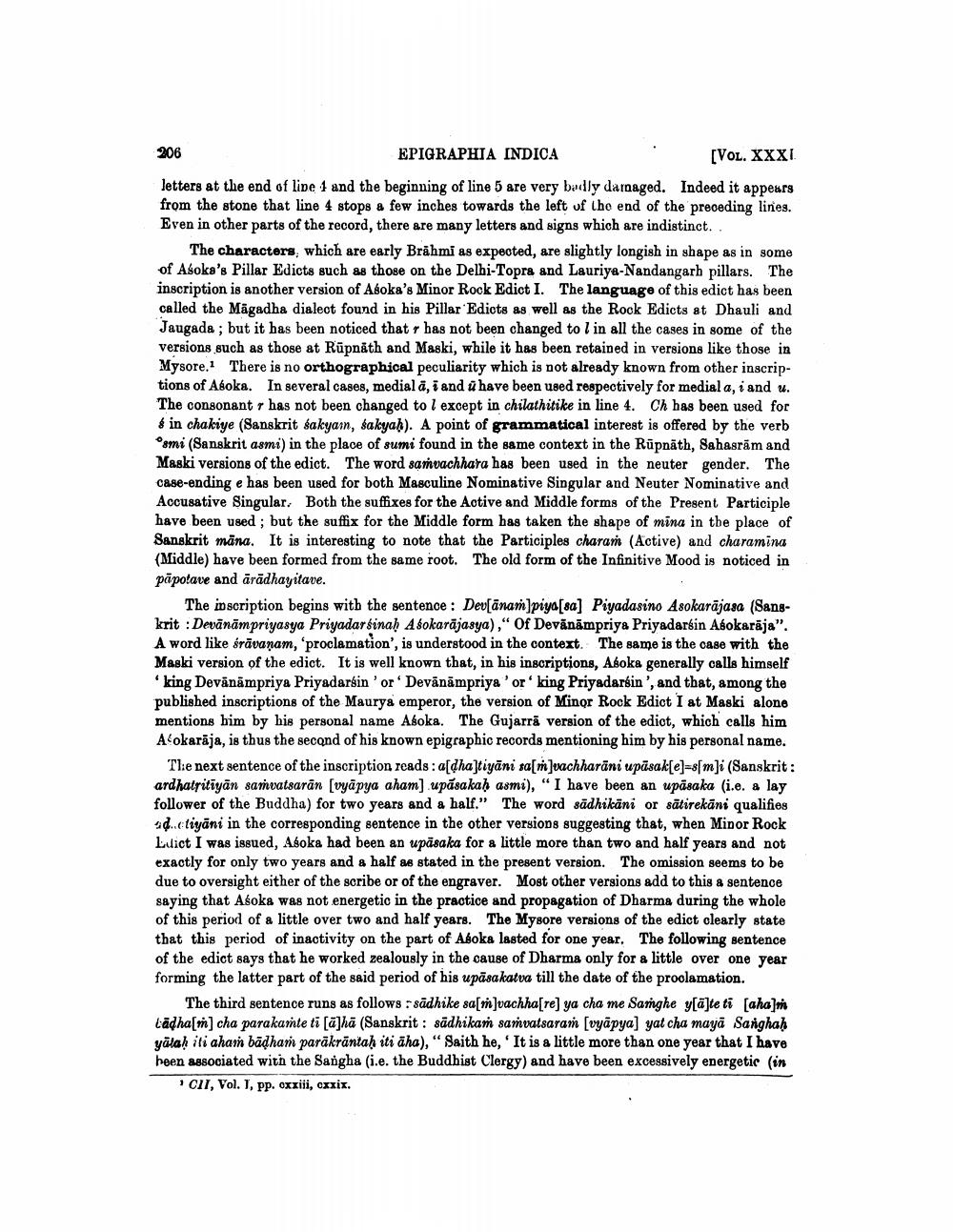________________
206
EPIGRAPHIA INDICA
[VOL. XXXI
letters at the end of line 4 and the beginning of line 5 are very badly damaged. Indeed it appears from the stone that line 4 stops a few inches towards the left of the end of the preceding lines. Even in other parts of the record, there are many letters and signs which are indistinct.
The characters, which are early Brahmi as expected, are slightly longish in shape as in some of Asoka's Pillar Edicts such as those on the Delhi-Topra and Lauriya-Nandangarh pillars. The inscription is another version of Asoka's Minor Rock Edict I. The language of this edict has been called the Magadha dialect found in his Pillar Edicts as well as the Rock Edicts at Dhauli and Jaugada; but it has been noticed that r has not been changed to l in all the cases in some of the versions such as those at Rupnath and Maski, while it has been retained in versions like those in Mysore. There is no orthographical peculiarity which is not already known from other inscriptions of Asoka. In several cases, medial a, i and u have been used respectively for medial a, i and u. The consonant r has not been changed to l except in chilathitike in line 4. Ch has been used for & in chakiye (Sanskrit sakyam, sakyah). A point of grammatical interest is offered by the verb smi (Sanskrit asmi) in the place of sumi found in the same context in the Rupnath, Sahasram and Maski versions of the edict. The word samvachhara has been used in the neuter gender. The case-ending e has been used for both Masculine Nominative Singular and Neuter Nominative and Accusative Singular. Both the suffixes for the Active and Middle forms of the Present Participle have been used; but the suffix for the Middle form has taken the shape of mina in the place of Sanskrit māna. It is interesting to note that the Participles charam (Active) and charamina (Middle) have been formed from the same root. The old form of the Infinitive Mood is noticed in papetave and ārādkayitare.
The inscription begins with the sentence: Dev[anam]piya[sa] Piyadasino Asokarājasa (Sanskrit: Devānāmpriyasya Priyadarsinah Aśokarājasya)," Of Devanāmpriya Priyadarsin Aśokarāja". A word like śrāvaṇam, 'proclamation', is understood in the context. The same is the case with the Maski version of the edict. It is well known that, in his inscriptions, Asoka generally calls himself 'king Devānāmpriya Priyadarsin' or ' Devanāmpriya' or king Priyadarsin', and that, among the published inscriptions of the Maurya emperor, the version of Minor Rock Edict I at Maski alone mentions him by his personal name Aśoka. The Gujarra version of the edict, which calls him Aśokarāja, is thus the second of his known epigraphic records mentioning him by his personal name.
The next sentence of the inscription reads: a[dha]tiyani sa[m]vachharāni upāsak[e]=s[m]i (Sanskrit: ardhatritiyān samvatsaran [vyāpya aham] upasakaḥ asmi), "I have been an upasaka (i.e. a lay follower of the Buddha) for two years and a half." The word sadhikāni or satirekāni qualifies adetiyani in the corresponding sentence in the other versions suggesting that, when Minor Rock Luict I was issued, Asoka had been an upāsaka for a little more than two and half years and not exactly for only two years and a half as stated in the present version. The omission seems to be due to oversight either of the scribe or of the engraver. Most other versions add to this a sentence saying that Asoka was not energetic in the practice and propagation of Dharma during the whole of this period of a little over two and half years. The Mysore versions of the edict clearly state that this period of inactivity on the part of Asoka lasted for one year. The following sentence of the edict says that he worked zealously in the cause of Dharma only for a little over one year forming the latter part of the said period of his upāsakatva till the date of the proclamation.
The third sentence runs as follows :sādhike sa[m]vachha[re] ya cha me Samghe y[a]te ti [aha]m tāḍha[m] cha parakamte ti [ā]hā (Sanskrit: sadhikaṁ samvatsaram [vyapya] yat cha maya Sanghaḥ yalaḥ iti aham bāḍham parākrāntaḥ iti aha), "Saith he, 'It is a little more than one year that I have been associated with the Sangha (i.e. the Buddhist Clergy) and have been excessively energetic (in
CII, Vol. I, pp. oxxiii, cxxix.




